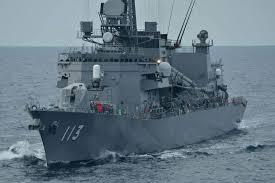
In a historic move, Japan has sent a warship through the Taiwan Straits. This marks the first time a Japanese vessel has made this passage. The ship, named JS Sazanami (DD-113), is an Aegis destroyer. It sailed in response to recent military maneuvers by China.
Just days earlier, a Chinese aircraft carrier passed near two Japanese islands. This raised concerns about regional security. As tensions rise, Japan seeks to assert its presence in the area. The passage of JS Sazanami is a clear signal of Japan’s intentions.
The warship was headed for military drills in the South China Sea. These exercises are part of Japan’s ongoing efforts to enhance its naval capabilities. Additionally, the South China Sea is a critical area for international shipping. Thus, Japan aims to ensure freedom of navigation.
Moreover, Australia and New Zealand also sent ships through the Taiwan Straits that day. Their presence underscores a united front among allies. This coalition enhances security in the Indo-Pacific region. It reflects a shared commitment to uphold international law.
Japan’s action is significant. It demonstrates a shift in Japan’s defense posture. Historically, Japan has adopted a pacifist stance since World War II. However, regional threats have prompted a re-evaluation of this approach. Consequently, Japan is increasing its naval operations.
The Taiwan Straits are a vital waterway that separates Taiwan from mainland China. China views Taiwan as part of its territory, so Beijing closely monitors any military activity in this area.
Japan’s government has expressed its concerns about Chinese military expansion. The Chinese military has ramped up its activities in the region, including frequent flights near Japanese airspace. Hence, Japan feels the need to respond decisively.
Furthermore, the U.S. has also emphasized the importance of freedom of navigation. The U.S. Navy conducts regular operations in the region. This supports allies like Japan, Australia, and New Zealand.
In addition, Japan’s defense minister commented on the situation. He stated that Japan will continue to strengthen its defense capabilities. He also highlighted the importance of regional stability. Therefore, Japan remains committed to working with its allies.
Public opinion in Japan is also shifting. Many citizens now support a stronger military presence. They believe it is necessary to protect Japan’s interests, and as a result, the government is more likely to take bold actions.
In conclusion, the passage of JS Sazanami through the Taiwan Straits is significant. It highlights Japan’s commitment to regional security and underscores the growing cooperation among allies. As tensions rise, Japan and its partners will continue to adapt their strategies, aiming to ensure peace and stability in the Indo-Pacific region.




